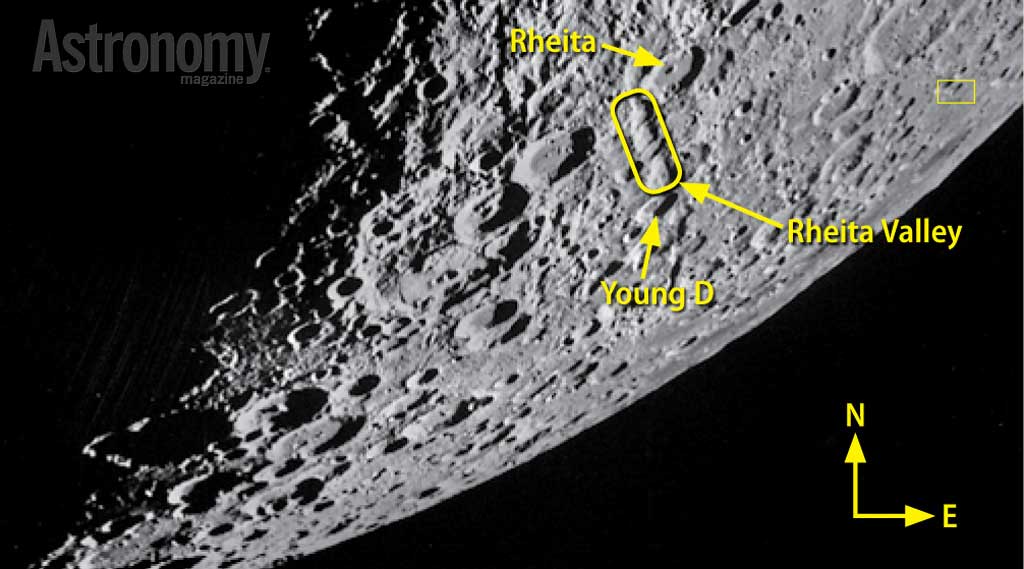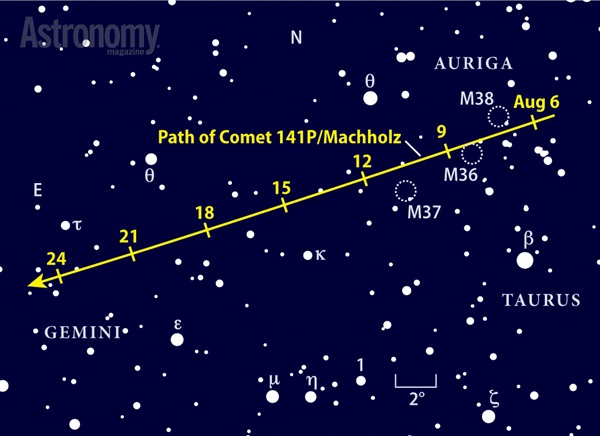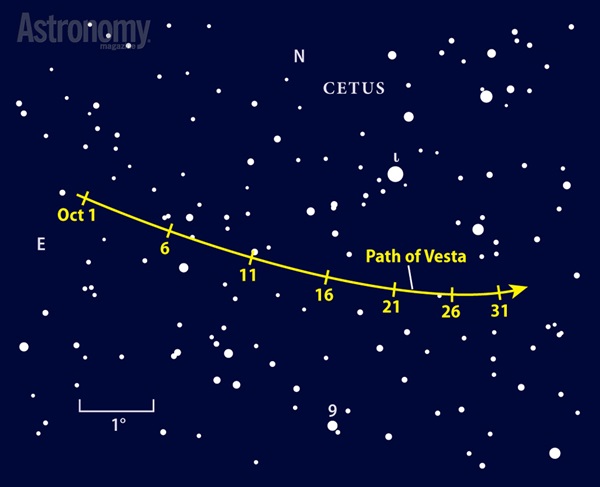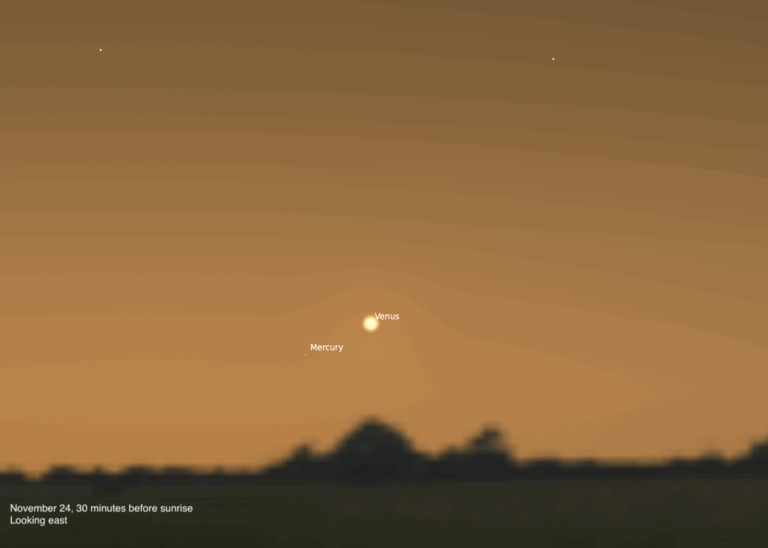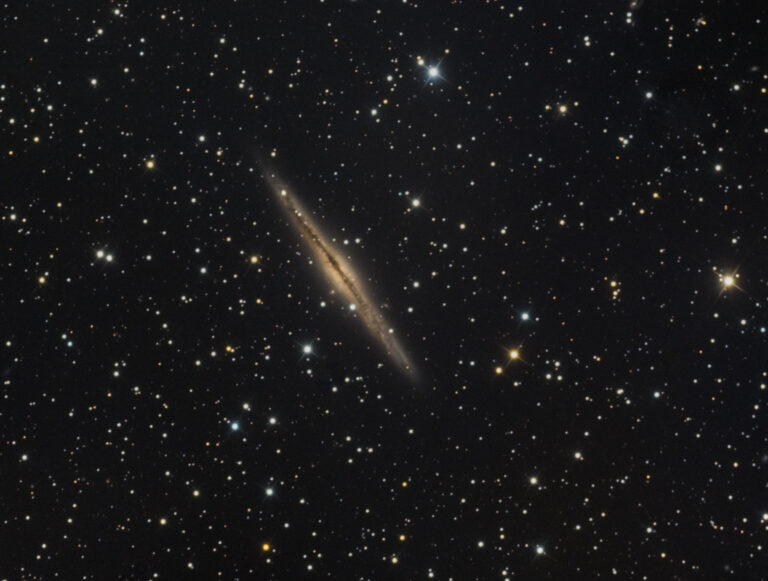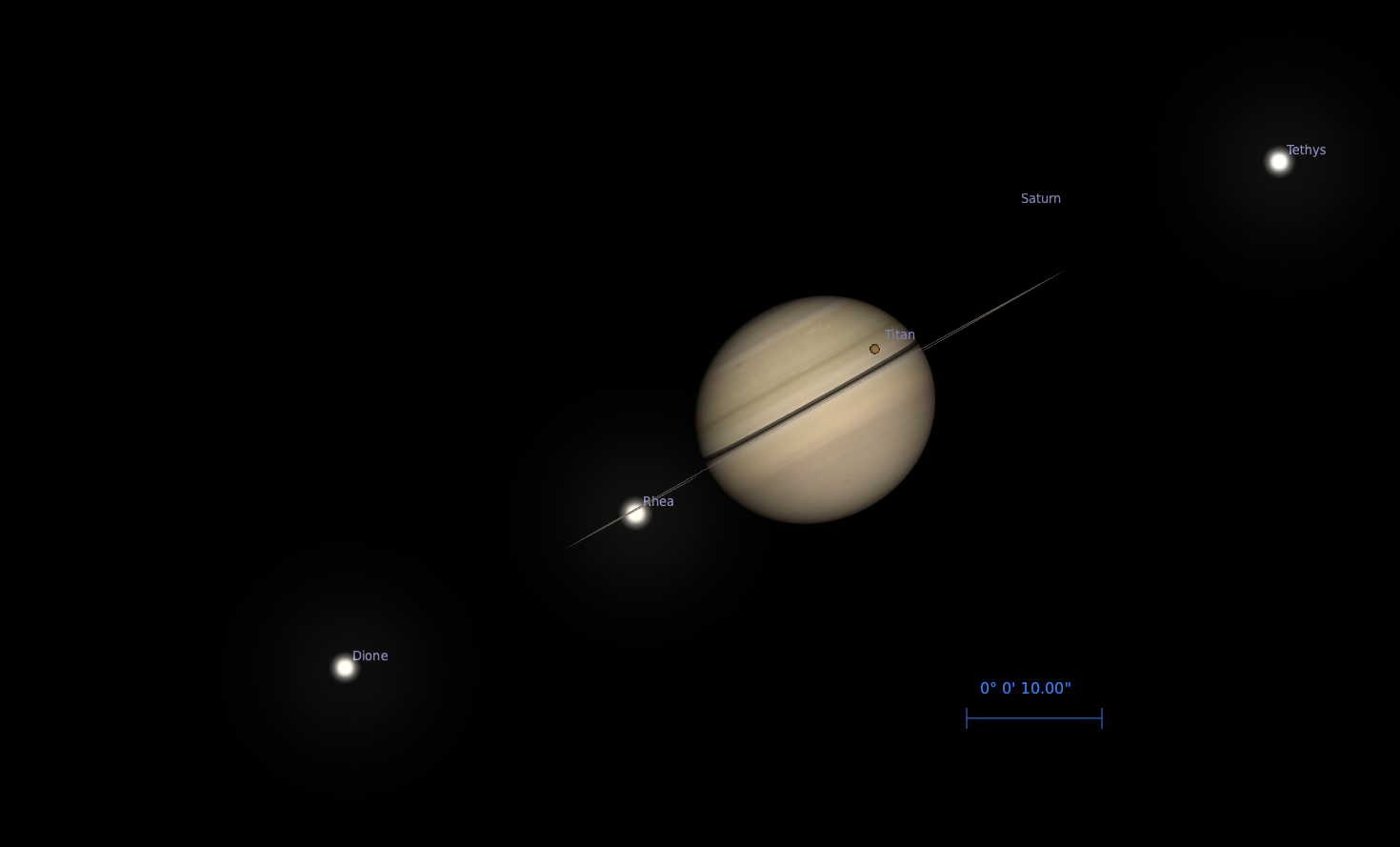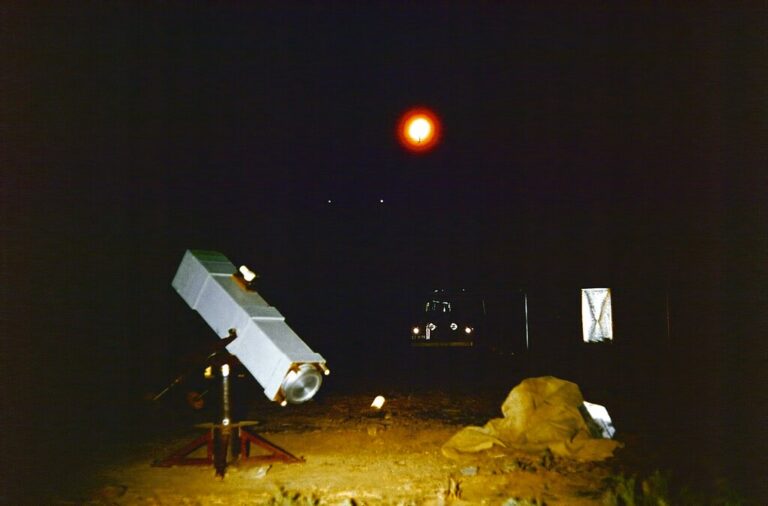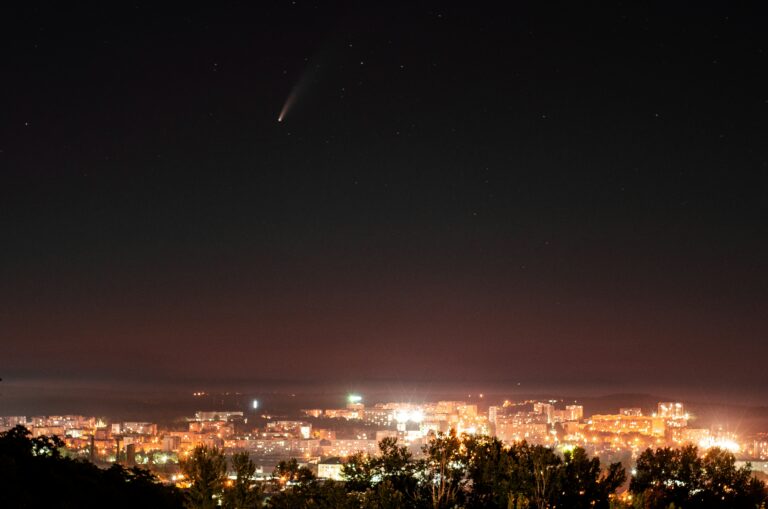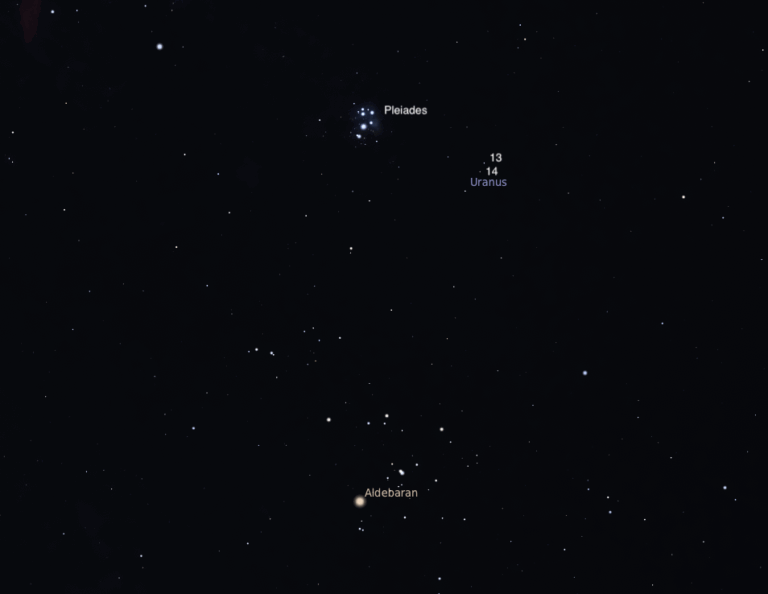Key Takeaways:
The predawn scene holds only half of what skygazers can look forward to this month, however. The outer solar system puts its own stamp on the evening and overnight hours. Beautiful Saturn leads the way, ruling the southwestern sky as darkness falls. Once twilight fades away, Neptune and Pluto take center stage. Uranus represents the final piece of October’s planetary puzzle. This distant ice giant reaches opposition and peak visibility in October, so it remains visible all night.
Our solar system tour begins with Saturn, which stands in the southwest as evening twilight falls. It forms a nice pair with ruddy Antares, located 10° southeast (left) of the planet. At magnitude 0.6, Saturn’s yellowish orb shines half a magnitude brighter than Scorpius’ lead star.
Look more carefully, and you’ll notice a closer and fainter companion: 2nd-magnitude double star Beta (β) Scorpii. As Saturn moves eastward relative to the background stars, the gap between it and Beta narrows. The planet passes 0.7° due north of Beta on October 24.
A waxing crescent Moon passes through the scene in mid-October. On the 15th, it lies 8° to Saturn’s right. The following evening, our satellite appears 6° to the planet’s upper left.
If you want to catch a view of Saturn through a telescope, do so early in the month. On October 1, the ringed planet stands about 15° high an hour after sunset. By month’s end, the gas giant has dropped to 5° altitude at the equivalent time and may be hidden by trees or buildings.
As soon as darkness settles in, target the planet to Saturn’s east: the icy dwarf Pluto. This distant world lies in northern Sagittarius, an area that stands 25° high in the south-southwest as twilight ends. With images pouring back from NASA’s New Horizons spacecraft, providing humanity with its first close-up look at this surprisingly active planet, there’s no better time to get your own view. You’ll need an 8-inch or larger telescope and a clear moonless sky or a telescope-camera combination that can reach to magnitude 14.2 Pluto.
You can find Pluto’s general location easily. It lies 5° due north of magnitude 2.1 Sigma (σ) Sagittarii in the handle of the Teapot asterism and within shouting distance of magnitude 3.5 Xi2 (ξ2) Sgr. During October, Pluto moves from a position 0.7° west of Xi2 to a spot just 0.4° west of this star. To confirm a sighting, sketch or image the field and return to it a night or two later. The object that changes location is the planet.
Pluto’s closest neighbor among large solar system objects is Neptune, and this ice giant world happens to be the next planet to rotate into prime position. Neptune lies among the background stars of central Aquarius. In early October, it appears well above the southeastern horizon after darkness falls and climbs highest in the south around 11 p.m. local daylight time. It reaches the same peak position two hours earlier by month’s end.
Neptune glows at magnitude 7.8, so you’ll need binoculars or a telescope to spot it. The planet lies 4° to 5° southwest of 4th-magnitude Lambda (λ) Aquarii. Once you locate this star, scan to the southwest for 5th-magnitude Sigma Aqr. On October 1, Neptune stands 2° northeast of Sigma and 0.9° due east of a 7th-magnitude sun. The planet’s motion carries it west-southwest this month, and by the 31st, it has cut the gap to this latter star in half. Target Neptune through a telescope, and you’ll see a blue-gray disk that spans 2.3″.
Head one constellation east of Neptune, and you’ll be in Pisces, the home turf of Uranus. The seventh planet reaches opposition the night of October 11/12, which means the world lies opposite the Sun in our sky and remains visible throughout the night. Uranus also lies closest to Earth (a still substantial 1.8 billion miles away) and shines brightest (magnitude 5.7) at opposition. You can spot it with naked eyes from under a dark sky, though binoculars make the task much simpler.
On October 1, Uranus stands 2° east-southeast of (below) Epsilon. The planet tracks westward all month but covers only about 1° of sky. It spends the last three weeks of October traveling just north
of a conspicuous triangle of 6th-magnitude stars. When viewed through a telescope, Uranus shows a 3.7″-diameter disk with a distinctive blue-green color.
As the outer planets wheel into the western sky on October mornings, the eastern sky comes alive with bright planets. Three of these worlds congregate near one another in Leo the Lion. Venus shines brightest at magnitude –4.6 trailed by Jupiter at magnitude –1.8 and Mars at magnitude 1.8.
On October 1, Venus rises around 3:30 a.m. local daylight time followed by Mars just after 4 a.m. and then Jupiter a half-hour later. Seventeen degrees separate the three in the predawn darkness. As pretty as this morning scene is, however, it only gets better as the planets close in on one another.
A waning crescent Moon joins the trio October 8. The spectacular gathering features Venus just 4° east of Luna with Mars and Jupiter 9° and 13° farther east, respectively. Leo’s brightest star, 1st-magnitude Regulus, adds to the display from a spot 2.5° to Venus’ northeast. The following morning, an even slimmer crescent Moon forms a compact triangle with Mars and Jupiter as Venus rides above.
On October 17, Mars passes less than a Full Moon’s width north of Jupiter while Venus stands 6.7° west of the pair — and closing. The 23rd finds Mars and Venus 4.5° apart with Jupiter midway between.
Another pretty vista beckons October 28 when Mars and Jupiter appear 4.5° apart with Venus hanging between the two. By October’s final morning, Jupiter stands highest while Venus has closed to within 1.4° of Mars. The latter two will experience a close conjunction of their own in early November.
October’s morning show looks great with naked eyes, binoculars, or a telescope. With the higher magnification a scope provides, you can track dramatic changes in Venus’ appearance. On October 1, Earth’s neighbor spans 33″ and appears 35 percent lit; by the 31st, it measures 23″ across with the Sun illuminating just over half of its disk.
Jupiter’s apparent diameter grows from 31″ to 33″ in October, and the world should show plenty of atmospheric detail. Unfortunately, Mars reveals a featureless disk 4″ across.
You’ll have to wait until twilight begins for a view of October’s final morning planet. Mercury reaches greatest western elongation the night of October 15/16, when it stands 18° from the Sun and climbs 8° above the eastern horizon 45 minutes before sunrise. Five days earlier (on the 11th), catch Mercury just 1° from the waning crescent Moon. The pair rises some 80 minutes before the Sun.
The innermost planet lies in Virgo, one constellation east of Leo and its three planets and thus lower in the predawn sky. Mercury shines at magnitude 0.2 on the 11th, brightens to magnitude –0.6 by greatest elongation, and gains a bit more luster by month’s end. A telescope reveals the inner world’s changing form. On the 11th, Mercury’s disk spans 8″ and appears one-third illuminated. By the 31st, its diameter has shrunk to 5″ and its phase has waxed to more than 90 percent lit.
When the timing is right, the wrinkle ridge Dorsa Smirnov provides one of the more striking sights on the floor of Mare Serenitatis (the Sea of Serenity). Thanks to the way the lunar cycle fits our calendar, this happens three times in October 2015. When the Sun lies low in the lunar sky, Dorsa Smirnov’s modestly lifted terrain casts shadows across the mare’s hardened lava plains. The prominently paired dark and sunlit faces disappear under
a higher Sun.
Because most amateur astronomers observe during evening hours, we normally focus on features visible just after lunar sunrise as the Moon waxes from crescent to Full. Yet during autumn evenings in the Northern Hemisphere, the Harvest Moon effect allows observers to view a waning gibbous Moon before midnight. On October 1, 2, and 31, the Sun begins to set over the Sea of Serenity in what some call “reverse lighting.”
Dorsa Smirnov, also called the Serpentine Ridge, extends nearly 150 miles. This complex of ridges formed billions of years ago as the weight of newly erupted lava caused the Serenity basin to sag. As the lava slid inward, compression caused the surface to buckle gently upward.
Classic lighting on Dorsa Smirnov occurs October 18 during the Moon’s evening crescent phase. Viewers in the western half of North America can catch the first rays of sunlight striking the top of the ridge on the 17th.
While you’re in the area, also take a few minutes to explore the wonderful crater Posidonius just to the northeast. It’s a joy getting lost in the magnificent detail of this 59-mile-wide impact feature. For starters, there are small craters, bumps, rilles, and a partial second wall.
Earth sweeps up debris cast off by Comet 1P/Halley twice every year. When our planet’s atmosphere incinerates these tiny dust particles in May, we get the Eta Aquariid meteor shower; when the process repeats in October, the Orionid shower reigns supreme.
The Orionids peak this year the night of October 21/22. The waxing gibbous Moon sets around 1:30 a.m. local daylight time, leaving four hours of dark skies for observers. The meteors appear to radiate from Orion the Hunter’s raised club, a region that climbs high in the south just before dawn. In its best years, the Orionids produce up to 70 meteors per hour, but astronomers predict 2015 rates closer to 15 per hour.
| WHEN TO VIEW THE PLANETS |
||
| Evening Sky |
Midnight | Morning Sky |
| Saturn (southwest) |
Uranus (south) |
Mercury (east) |
| Uranus (east) |
Neptune (southwest) |
Venus (east) |
| Neptune (southeast) |
Mars (east) |
|
| |
Jupiter (east) |
|
| Uranus (west) |
||
The comet making the biggest splash in 2015 has to be 67P/Churyumov-Gerasimenko, the two-lobed object seen in stunning detail by the European Space Agency’s Rosetta spacecraft. Observers should get some of their best views of the comet in October. If we’re lucky, the dirty snowball may outburst and glow at 10th magnitude, within reach of a 4-inch telescope under a dark sky. If not, 67P could be 12th magnitude and require an 8-inch or larger aperture.
The comet resides among the background stars of Leo, near the splendid gathering of bright morning planets. Start watching October 9 when a slim crescent Moon joins the lineup. But this is just a prelude to a suite of dazzling dawns. Comet 67P lies a short hop from Venus and Regulus, and passes a mere 16′ north of magnitude 3.5 Eta (η) Leonis on the 15th.
To see the most detail, pump up the magnification past 100x. Although the extra power spreads out the light a bit, it is the only way to notice that 67P’s eastern flank sports a well-defined edge where the solar wind interacts with the comet’s escaping gas.
Although asteroid 4 Vesta fades from magnitude 6.2 to 6.8 during October, it remains the brightest minor planet. You’ll find it an easy target through binoculars from the suburbs and barely within reach of naked eyes from a dark site early in the month. Having reached opposition in late September, it remains visible nearly all night, climbing highest in the south around midnight local daylight time.
To find Vesta, first locate magnitude 2.0 Beta (β) Ceti. Then point your binoculars 10° to the north-northwest at magnitude 3.5 Iota (ι) Ceti. During the latter half of October, Vesta will be the brightest point of light south of Iota.
As a bonus for observers at mid-northern latitudes, Vesta lies within the same binocular field as the similarly bright geostationary satellites. These satellites orbit directly above Earth’s equator at an altitude of 22,236 miles. They can get as bright as 4th magnitude, and in some constellations like Cetus, the extra “stars” look obvious to experienced observers.
From mid-northern latitudes, the satellites appear some 5° to 7° below the celestial equator, or a little above Vesta. The satellites appear brightest in October and early February when the Sun lies at the same declination, allowing mirror-like reflections off their solar panels.
Martin Ratcliffe provides planetarium development for Sky-Skan, Inc. from his home in Wichita, Kansas. Meteorologist Alister Ling works for Environment Canada in Edmonton, Alberta.





